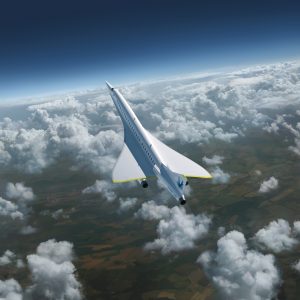Anyone who believes that the prospects for faster-than-sound civil air transport evaporated in the wake of Aerion Supersonic’s recent collapse should think again.
Despite the funding shortfall that led Aerion to cease operations—it was on the cusp of full-scale development of its Mach 1.4 AS2 business jet—other supersonic contenders are continuing to forge ahead.
One of them is Boom Supersonic, which is also testing a sub-scale commercial aircraft called Overture designed to carry up to 88 passengers cruise at Mach 1.7. At that speed, travel times between destinations of up to 4,250 nm would be about half of what it takes conventional airliners to cover. Moreover, it will use 100% sustainable aviation fuel (SAF). Boom anticipates the start of production in 2025, with entry into service in 2025.
There’s no lack of evidence of the market opportunity. United Airlines, the first official U.S. customer, has firm orders for 15 of the aircraft, provided they meet the carrier’s “safety, operating and sustainability requirements.” United also has an option to purchase an additional 35 Overtures and plans to collaborate with Boom to develop and improve production sources for net-zero carbon-footprint SAF.
“United continues on its trajectory to build a more innovative, sustainable airline, and today’s advancements in technology are making it more viable for that to include supersonic [aircraft],” United CEO Scott Kirby said.
Further evidence of strong interest in reviving commercial supersonic flight comes from Japan Airlines, which secured options to purchase 20 Overtures, and Virgin Atlantic, which secured options for 10. In addition, Virgin has long-term plans to study a high Mach long-range air transport project of its own.
Overture’s design also will include the capability to meet the same Stage 5 noise limits for take-off and landing as current conventional airliners. However, the delta-winged aircraft will generate a sonic boom at cruise speeds above Mach 1 and therefore—like the supersonic Anglo-French Concorde which made its last flight in 2003—will not be permitted to break the sound barrier over land.
Nonetheless, the technologies associated with supersonic flight are far more advanced than when Concorde was being designed in the mid-1960s. Perhaps most notable are the huge advances that have been made in propulsion and acoustics.
Despite Overture’s restriction from flying over land, Boom expects the aircraft’s operating costs to be 75% lower than those of Concorde, enabling profitable operations solely on trans-oceanic routes at business-class ticket prices or less, according to Boom founder and CEO Blake Scholl, referring to the Anglo-French supersonic transport which was retired in 2003 after 27 years of service.
As interest revives in commercial supersonic aircraft, NASA is preparing to flight test the Lockheed Martin-built X-59 Quiet Supersonic Technology experimental aircraft. Designed to reduce the intensity of sonic booms, the aircraft will provide data that will help lawmakers develop noise guidelines for future supersonic aircraft designers.
Morgan Stanley analyst Chelsea Cansino believes that technological developments could be the catalyst for supersonic travel’s resurgence, but fuel costs, demand and safety will be areas to watch.
Noting that Concorde was not economically viable and was too noisy to be used at most airports, among other issues, Scholl said, “Learning from Concorde and building upon its foundation, we defined three core principles to guide every strategic decision and facet of this organization—speed, safety and sustainability. For us, these principles enable supersonic flight that is affordable for passengers, profitable for airlines and capable of reaching economies of scale with tens of millions of passengers.”
Early in Overture’s design, Boom’s technical team planned for speeds of up to Mach 2.2 but that was reduced to Mach 17. That decision was based on more detailed analysis of propulsion options with Rolls-Royce and reflects a closer focus on fuel efficiency and airport noise, according to Scholl.
Flight tests of the one-third scale supersonic demonstrator, XB-1, are expected to begin in Mojave, Calif., by late 2021 or early 2022. The 71-ft-long trijet currently is undergoing final ground tests at Boom’s Centennial, Col., headquarters and will begin engine tests in the near future.